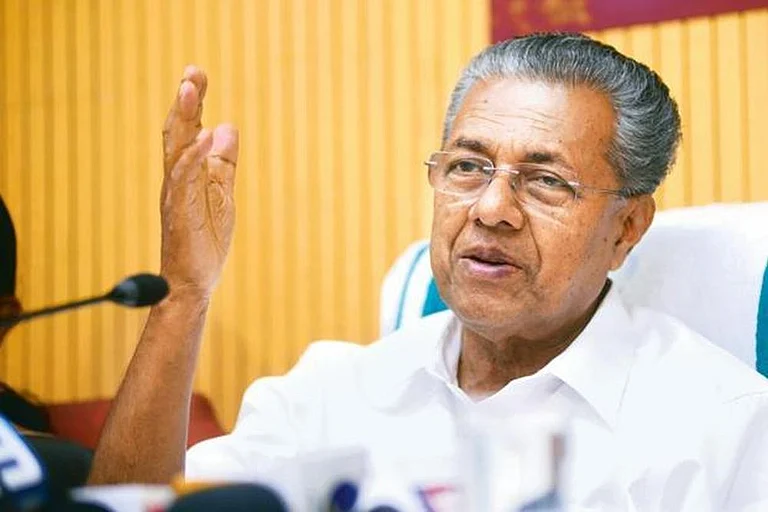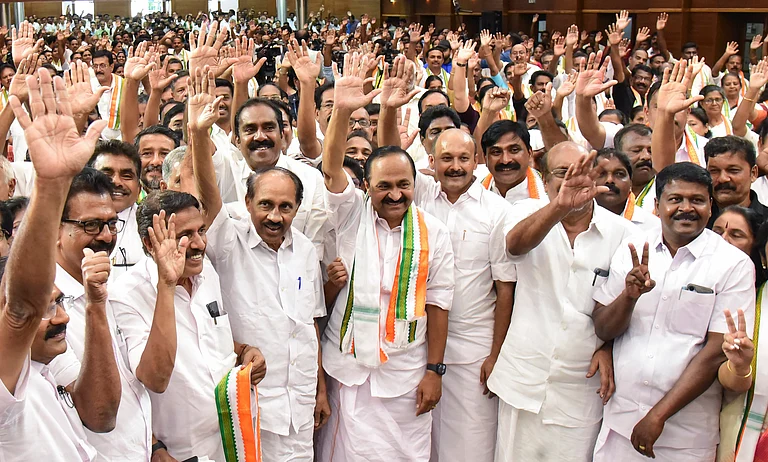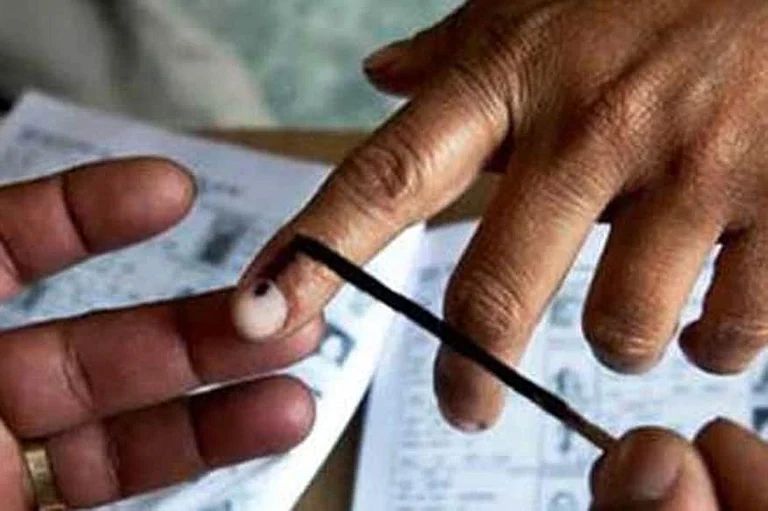It is 2 pm on April 4 in Kakkuni, Vadakara constituency. A large number of people have gathered under the blazing sun for a public meeting of the Left Democratic Front (LDF) candidate K K Shailaja. The crowd, particularly women, surround the former health minist er expressing their love and affection, chanting slogans and listening attentively to her brief speech.
On the other side, the United Democratic Front (UDF) candidate and sitting MLA, Shafi Parambil, the youthful face of the Congress, receives an equally enthusiastic response during his roadshow. Around 5,000 women—Shailaja’s mass base—are on the streets to display their support to Parambil. A member of the legislative assembly representing Palakkad, Parambil was a surprise addition to the UDF’s line-up. In 2021, he won against the Bharatiya Janata Party (BJP) candidate, ‘Metro man’ E Sreedharan, and emerged as one of the most promising young leaders in the Congress.
During the final stretch of the election, as we journeyed through approximately seven constituencies in northern Kerala, we noticed a surprising emptiness on the streets, with the exception of Vadakara. The bustling energy depicted on social media did not align with the subdued atmosphere outdoors. One prominent reason for this is the intense summer heat, reportedly the worst in 50 years, which has deterred people from venturing out during daytime. Instead, social media platforms were flooded with videos and images of vibrant night marches, indicating that the true election fervour seemed to thrive only in the evening and night.
Vadakara stands out from the rest of the seats going to the polls. The constituency—once a stronghold of the Left—has witnessed a significant shift since 2009. The murder of T P Chandrasekharan, the CPI(M) rebel, who formed the Revolutionary Marxist Party (RMP) in 2012, dealt a severe blow to the LDF in this constituency, leading to an apparent shift in favour of the UDF ever since. That is precisely why Shailaja’s candidacy reflects the CPI(M)’s determined effort to reclaim this seat. In response, the Congress has fielded Parambil, who the party feels can challenge Shailaja’s stature.
Personal Attacks Take Centre Stage
However, the intense political contest took a disturbing turn with cyber attacks against Shailaja, alleging corruption in the purchase of COVID-19 kits. Though these accusations have been surfacing since 2021, no substantial evidence has been presented. The attacks on Shailaja escalated to an appalling extent, with her photos being manipulated alongside pornographic imagery. The veteran politician was visibly shaken, breaking down in tears during a press conference. She said that she had never experienced such personal and vicious attacks before in her life.
It has been alleged that the UDF is trying to create a polarisation of the Muslim vote in favour of Parambil. Screenshots of messages asking for ‘casting the core for a Muslim’ circulated on WhatsApp groups that were exposed by the Left camp. The social media handles of the Left retaliated by calling Parambil a ‘communal fanatic’. The furious and ugly fight has become the only point of discussion in Kerala.
It is interesting that Kerala has different voting parameters for assembly and Parliamentary elections.
In the final stretch, the campaign took on a communal undertone. Parambil, although a Congress representative, is seen as the blue-eyed boy of the Indian Union Muslim League (IUML), which has embraced his candidacy as its own. Vadakara, which has a substantial Muslim population, is known for its secular ethos and has historically demonstrated that the candidates’ religious affiliations do not significantly impact their electability. This trend is evident in the assembly segments within Vadakara as well. For instance, in the Nadapuram assembly constituency, where approximately 40 per cent of the population is Muslim, the electorate elected E K Vijayan of the CPI in the 2021 state elections.
Lower Voter Turnout
While the Wayanad constituency garnered significant attention, given the obvious reasons, the on-ground contest didn’t appear to be tight. Annie Raja’s candidacy against Rahul Gandhi has somewhat shifted the political dynamics, as compared to the previous election, when the LDF—caught off guard by Gandhi’s entry—fielded P P Suneer, a local party leader, without a clear strategy. This time, they are determined to put up a strong fight against Gandhi, and the late entry of the BJP’s state president K Surendran has tightened the electoral race.
The decision to refrain from displaying the IUML’s party flags at Gandhi’s rallies—out of concern that the BJP might exploit them nationally for a misinformation campaign by associating the IUML’s green flags with Pakistani flags—has stirred dissatisfaction among the rank and file of the IUML. Despite attempts by the UDF leadership to downplay the issue, this move has led to widespread disappointment among young IUML workers, with the UDF fearing that this might have some impact on their prospects in north Kerala.
The lack of enthusiasm in the IUML camp seems to have been reflected in the polling. All constituencies in north Kerala, where the IUML is strong, witnessed a considerably lower voter turnout compared to 2019. The total polling in the state stood at 71.27 per cent, which is 6.57 per cent lower as compared to 2019. Historically, a low voter turnout has been advantageous to the LDF. Apparently, the LDF camp is hoping to win not less than 10 seats.
Significantly, it must be also kept in mind that Kerala has different voting parameters for assembly and Parliamentary elections. Though Kerala has alternatively voted for the LDF and the UDF in state elections, it has consistently supported the Congress and its allies in the Lok Sabha elections.
The BJP’s Increasing Presence
In the electoral battleground of Thrissur, where a three-pronged clash unfolded, all eyes were fixed on Suresh Gopi, the BJP’s star-turned-politician. The constituency gained instant attention when the Congress replaced its sitting MP, T N Prathapan, with K Muraleedharan, following the defection of Muraleedharan’s sister, Padmaja Venugopal, to the BJP camp. Meanwhile, the CPI strategically fielded V S Sunil Kumar, a former minister, as its contestant. The fall in voter turnout, however, casts a shadow over the expectations of the BJP. Thrissur recorded 72.9 per cent polling, which marks a five per cent drop as compared to 2019. Though all parties claim victory, the assembly segment-wise voter turnout gives an edge to the Left.
In the capital constituency of Thiruvananthapuram, where incumbent MP Shashi Tharoor of the Congress is fighting Union Minister Rajeev Chandrasekhar and CPI veteran Pannyan Raveendran, the voter turnout holds significant weight. With a turnout of 66.46 per cent, well below the constituency’s average and even lower than the higher turnout seen in 2019, the dynamics are notable. The Congress camp finds solace in the urban assembly segments, where the BJP typically garners support, showing a more significant decrease in voting. Moreover, the coastal belt, which tends to favour Tharoor, has displayed a better turnout. However, a silent but crucial factor lies in the potential consolidation of minority votes in favour of the LDF. This is influenced by Tharoor’s perceived wobbly stance on issues such as the war on Gaza and the Citizenship (Amendment) Act, 2019, which hasn’t resonated well with the Muslim community.
Irrespective of the fierce fight between the UDF and the LDF, Kerala is anxiously waiting to know one thing: will the BJP open its account in the state this time?
MORE FROM THIS ISSUE
Shahina K K in Vadakara, Kerala
(This appeared in the print as 'Left Side Story')


































